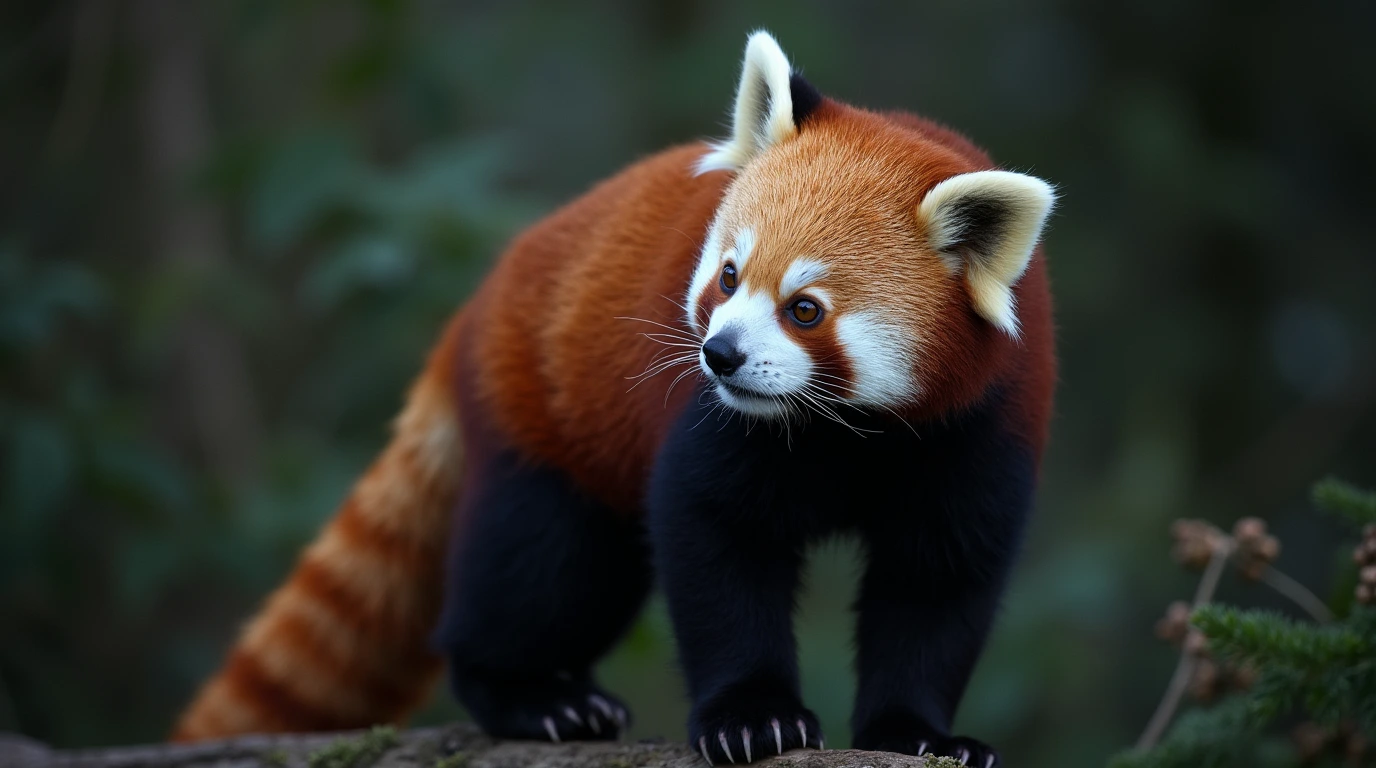The red panda’s nocturnal nature plays a vital role in its survival strategy, helping it avoid predators and navigate a habitat filled with potential threats. Active primarily at night and during the twilight hours of dawn and dusk, red pandas reduce their risk of encountering diurnal predators like snow leopards, martens, and raptors. This timing allows them to move quietly under the cover of darkness, using their excellent low-light vision and heightened senses to forage, travel, and communicate with minimal detection
In their high-altitude forest habitats, where visibility is low and predator pressure can be intense, red pandas benefit from the safety of the night. Their reddish-brown fur blends with tree bark and mosses, making them even harder to spot. Additionally, their arboreal lifestyle and slow, deliberate movement patterns enhance their stealth
This article explores how the red panda’s nocturnal behavior minimizes its exposure to predators, the sensory and environmental adaptations that support nighttime activity, and the role of seasonal and human-driven influences on these patterns
How Red Panda Nocturnal Behavior Reduces Predator Risk

Red pandas have adapted to a nocturnal and crepuscular lifestyle that allows them to avoid many of the predators that pose a threat during daylight hours. In the dense forests of the Himalayas and southwestern China, survival often depends on remaining undetected, and for red pandas, the cover of darkness offers a significant advantage
Predators of Red Pandas and Their Activity Patterns
The most common natural predators of red pandas include snow leopards, yellow-throated martens, and large birds of prey. Snow leopards are largely diurnal and crepuscular, meaning they hunt during the early morning and late afternoon. These predators are skilled stalkers that rely heavily on sight, making daytime a more dangerous period for red pandas to be active. Similarly, birds of prey, such as hawk-eagles, pose a threat from above during daylight hours when they can spot movement from the canopy
Martens, while more versatile in their activity patterns, still show higher activity levels during daylight hours, particularly in areas where they compete with other predators. By confining their foraging and movement to nighttime hours, red pandas minimize the overlap in active periods with their main predators. This temporal separation dramatically reduces the chance of encounters and allows red pandas to move and feed with a greater degree of safety
Field studies, including those cited in Just Nature Travel, highlight this behavior, noting that red pandas are rarely observed during the day unless they are sleeping in treetop hollows or dense foliage. This low visibility is a key survival mechanism in habitats where stealth is more effective than speed or confrontation
Advantages of Nocturnality for Solitary Species
Red pandas are solitary animals, meaning they do not benefit from the safety of a group or collective vigilance. Their small size and solitary nature make them more vulnerable to attacks. Nocturnality helps mitigate this vulnerability by reducing the frequency of predator encounters. At night, red pandas can rely on their environment and instincts to avoid detection rather than depending on group behavior
Being nocturnal also reduces competition for food resources. Many other species that inhabit the same ecosystem are diurnal, so by foraging at night, red pandas gain better access to bamboo and other foraged items without interference. This separation of active periods not only helps in avoiding predators but also in optimizing food collection
Additionally, red pandas’ natural silence and slow, cautious movements suit their nighttime activity. They are not fast runners or aggressive fighters, so stealth and timing are their best defenses. These characteristics align perfectly with a nocturnal schedule, allowing them to move undisturbed through the forest while predators rest
How Red Pandas Use the Forest at Night for Safety
The forest itself offers red pandas a defensive advantage, especially during the night. Red pandas are arboreal, meaning they spend most of their time in trees. At night, they move through the forest canopy, navigating across branches and avoiding open ground where they are more exposed. The dense foliage of bamboo and broadleaf trees provides visual cover and multiple escape routes if danger approaches
This arboreal movement is made possible by their physical adaptations, such as sharp claws and a pseudo-thumb that enhance grip and balance. These adaptations, combined with their nocturnal behavior, allow red pandas to move through the forest with minimal noise or disruption. Their reddish-brown fur blends with the moss-covered branches and bark, enhancing camouflage under low-light conditions
Red pandas often rest during the day in tree hollows or on thick branches where they are well-concealed. When night falls, they emerge from these shelters and begin their foraging activities, taking full advantage of the quiet, shadow-filled environment. In this way, the structure and shading of the forest complement their behavior, creating a synergy that reduces their risk of being hunted
By using the darkness as a shield, limiting their activity to periods when predators are less active, and capitalizing on the vertical complexity of their forest homes, red pandas have developed a highly effective strategy for predator avoidance. Their nocturnal behavior is not simply a feeding schedule but a carefully evolved survival tactic that reflects the risks and demands of their environment
Sensory and Environmental Adaptations for Night Activity

The red panda’s ability to remain active during the night is supported by a suite of finely tuned sensory and environmental adaptations. These traits help them navigate their habitat in low light, detect potential threats, and forage effectively while avoiding predators. Combined with their arboreal lifestyle, these adaptations make red pandas efficient and elusive nocturnal foragers
Red Panda Sensory Adaptations for Nocturnal Foraging
Red pandas have developed sensory mechanisms that enhance their ability to function in the darkness of night. One of the most important is their enhanced night vision. Though not as specialized as some nocturnal predators, red pandas have good low-light vision that allows them to detect shapes, motion, and food items in dim forest conditions. Their large, forward-facing eyes give them better depth perception, which is essential for moving through trees and across uneven terrain in the dark
Their sense of smell is also highly refined. Red pandas use scent for communication, navigation, and food detection. They have scent glands located at the base of their tail and on the soles of their feet, which they use to mark trails and territory. These scent markers help them retrace paths, avoid conspecifics, and signal reproductive status. At night, when visual cues are limited, olfactory signals become especially valuable
Additionally, red pandas have acute hearing. Their ability to detect subtle forest sounds—like the movement of a predator or the rustling of leaves—provides early warnings that enhance their chances of avoiding confrontation. This auditory acuity is particularly important in nocturnal settings where visibility is reduced
The Role of Camouflage in Nighttime Movement
Camouflage is another vital element in the red panda’s nocturnal defense toolkit. Their reddish-brown fur matches the colors of tree trunks, mosses, and reddish lichen, especially in low-light forest conditions. At night, this natural coloration makes them nearly invisible to the untrained eye and helps them blend into the forest background
During nighttime movement, red pandas remain close to the trunks and large branches of trees, minimizing their exposure to open space where they could be more easily spotted. They typically move slowly and deliberately, reducing the noise that might alert nearby predators or draw unwanted attention. Their deliberate movements, in combination with their camouflage, make them particularly difficult to detect—whether by natural predators or researchers
In areas with snow cover, their dark limbs and belly fur still provide contrast that breaks up their outline, while their high-altitude forests tend to remain shaded and structurally complex, offering continued concealment. This visual blending with the forest floor, canopy, and snow ensures protection throughout all seasons, especially when they are most active in low-light hours
Forest Structure and Cover in Avoiding Detection
Red pandas use the vertical complexity of the forest to their full advantage. They are rarely seen on the ground unless moving between trees. The dense canopy and understory of bamboo and broadleaf trees create a labyrinth of branches and foliage that provides ample cover. At night, this environment becomes even more effective as a hiding space, with shadows and structural obstructions limiting the visibility of even the most agile predator
The forest not only conceals red pandas visually but also helps dampen sound. Bamboo groves and wet mountain forests are acoustically absorbent, reducing the chance that a predator will hear the subtle movements of a red panda. This natural soundproofing enhances the stealth that nocturnal animals like red pandas rely on for safety
Moreover, red pandas are highly familiar with their territory. They know the location of key feeding trees, escape routes, and resting sites. This spatial memory allows them to move efficiently and confidently under the cover of darkness, reducing their exposure to threats while maintaining effective foraging routines
According to Google Arts & Culture, red pandas’ tree-dwelling nature and agility help them traverse branches silently, giving them access to food sources and escape paths that are inaccessible to many predators. Their combination of sensory sharpness, environmental knowledge, and stealth makes them uniquely adapted to their nocturnal niche
Seasonal and Human-Driven Influences on Nocturnal Patterns

While red pandas are inherently nocturnal and crepuscular, their activity patterns are also influenced by seasonal shifts and increasing human presence in their natural habitats. These external factors can intensify or suppress nocturnal behavior, as red pandas adapt in real time to minimize risks and maximize energy efficiency. Their behavioral flexibility demonstrates a remarkable capacity to navigate both natural and anthropogenic challenges
Seasonal Shifts in Red Panda Activity and Predator Avoidance
Seasonal changes affect the daily rhythms of both red pandas and their predators. In warmer months, predators such as snow leopards tend to be more active during early mornings and late afternoons, which often coincides with increased daylight and food availability. To avoid these threats, red pandas shift their activity more firmly into nighttime hours. The extended summer daylight also allows more human and livestock activity in forests, further encouraging red pandas to retreat into deeper nocturnal behavior
Conversely, in the colder months of winter, predator activity may diminish due to snow cover and reduced mobility. Red pandas also become less active, not only because of the drop in temperature but due to the lower caloric value of bamboo leaves available during that time. As their food becomes less nutritious, red pandas conserve energy by decreasing movement and may show reduced activity even during their typical nocturnal windows
This seasonal behavior is not static. Instead, it demonstrates how red pandas use behavioral plasticity—adjusting not just when but how and where they are active based on current threats and resource distribution. Their timing remains an important element of survival, whether avoiding predators or coping with food scarcity
Effects of Human Presence on Red Panda Behavior
Human encroachment and forest disturbance have increasingly influenced red panda behavior. Activities like herding, wood collection, road construction, and tourism often peak during daylight hours. Red pandas respond to these stressors by modifying their temporal activity, becoming more nocturnal in regions with high human disturbance
According to studies from Habre’s Nest, red pandas in protected forests with minimal human intrusion exhibit more crepuscular patterns, while those in human-dominated landscapes show delayed emergence from dens and greater activity during night hours. This shift minimizes contact with people and reduces stress-related behaviors, but it also limits their access to some food sources, particularly those that are easier to locate or process in daylight
Over time, red pandas may become increasingly dependent on remote forest patches or alter their core home ranges to remain within areas of lower human visibility. These adjustments come at a cost—longer travel distances, fragmented feeding opportunities, and increased isolation. Still, the trend toward nocturnality in the face of human pressure reflects the species’ instinct to prioritize survival over convenience
Adaptive Movement Patterns in Fragmented Habitats
As habitat fragmentation increases due to deforestation and land conversion, red pandas are forced to adapt their movement patterns to remain safe and undetected. Nocturnality becomes an even more important tool in these conditions. Forest corridors, even when narrow or degraded, can be traversed more safely under the cover of darkness, allowing red pandas to move between patches without exposing themselves during the day
These night movements are generally slower and more cautious, especially in unfamiliar terrain or areas lacking dense cover. In regions where forest corridors intersect with roads or agricultural plots, red pandas tend to cross these spaces at night, reducing the risk of human conflict or vehicle collisions. While this behavior enables connectivity between habitat patches, it also increases their energy expenditure and vulnerability during transitions
Red pandas in fragmented forests have also been observed modifying their use of space, using more vertical terrain and staying closer to cover, particularly at night. Their ability to map and remember safe routes is critical, allowing them to revisit secure feeding and resting spots while avoiding open ground. This adaptive spatial behavior, combined with their natural nocturnality, makes red pandas among the more elusive and cautious forest dwellers
As highlighted by Just Nature Travel, their capacity to move quietly under moonlight while navigating dense foliage allows them to coexist in increasingly human-impacted environments, although not without cost. Conservation strategies must consider these behavioral changes to ensure that red pandas are not merely surviving in silence but thriving in secure, undisturbed forest ecosystems













